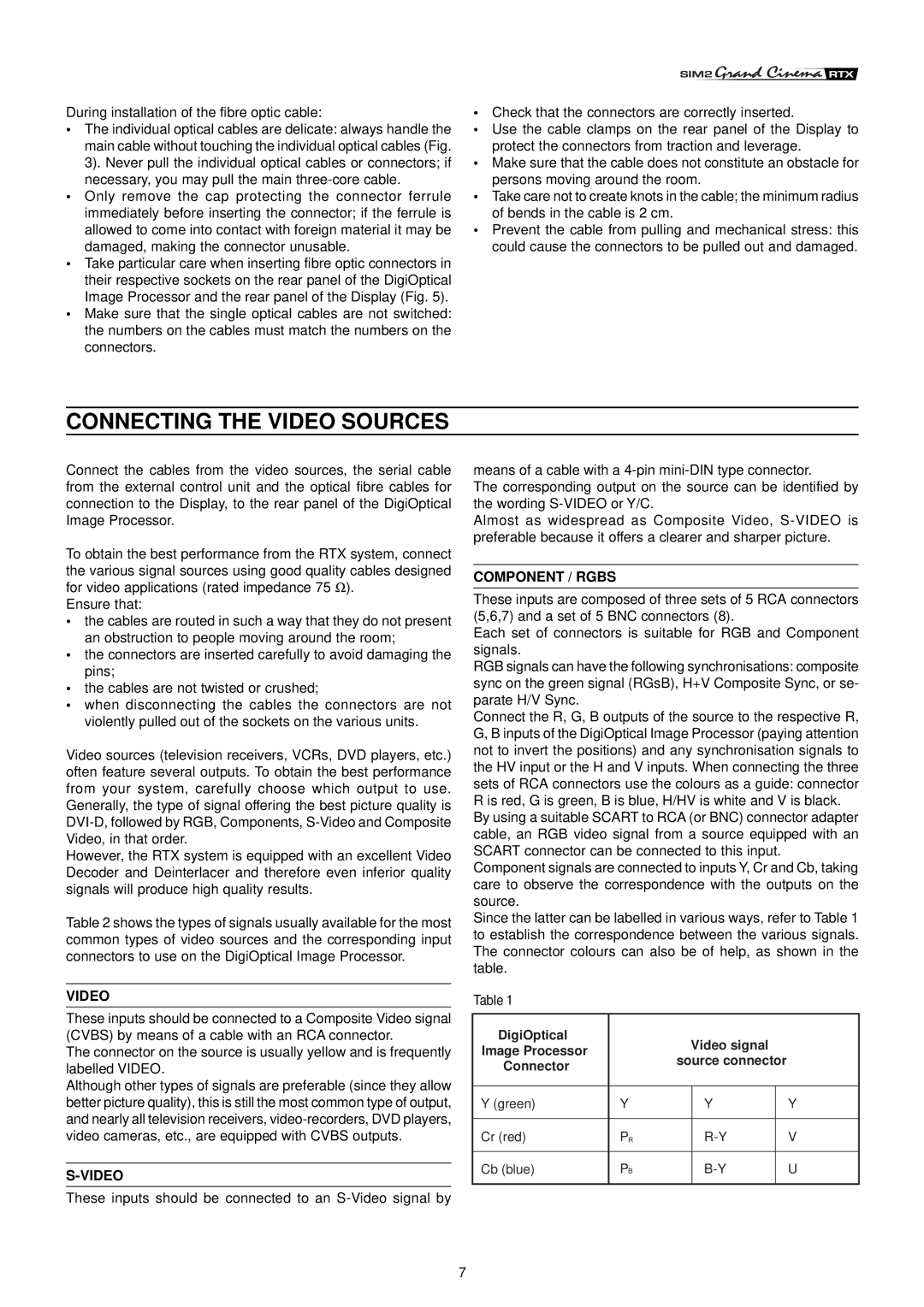
During installation of the fibre optic cable:
•The individual optical cables are delicate: always handle the main cable without touching the individual optical cables (Fig. 3). Never pull the individual optical cables or connectors; if necessary, you may pull the main
•Only remove the cap protecting the connector ferrule immediately before inserting the connector; if the ferrule is allowed to come into contact with foreign material it may be damaged, making the connector unusable.
•Take particular care when inserting fibre optic connectors in their respective sockets on the rear panel of the DigiOptical Image Processor and the rear panel of the Display (Fig. 5).
•Make sure that the single optical cables are not switched: the numbers on the cables must match the numbers on the connectors.
•Check that the connectors are correctly inserted.
•Use the cable clamps on the rear panel of the Display to protect the connectors from traction and leverage.
•Make sure that the cable does not constitute an obstacle for persons moving around the room.
•Take care not to create knots in the cable; the minimum radius of bends in the cable is 2 cm.
•Prevent the cable from pulling and mechanical stress: this could cause the connectors to be pulled out and damaged.
CONNECTING THE VIDEO SOURCES
Connect the cables from the video sources, the serial cable from the external control unit and the optical fibre cables for connection to the Display, to the rear panel of the DigiOptical Image Processor.
To obtain the best performance from the RTX system, connect the various signal sources using good quality cables designed for video applications (rated impedance 75 Ω ).
Ensure that:
•the cables are routed in such a way that they do not present an obstruction to people moving around the room;
•the connectors are inserted carefully to avoid damaging the pins;
•the cables are not twisted or crushed;
•when disconnecting the cables the connectors are not violently pulled out of the sockets on the various units.
Video sources (television receivers, VCRs, DVD players, etc.) often feature several outputs. To obtain the best performance from your system, carefully choose which output to use. Generally, the type of signal offering the best picture quality is
However, the RTX system is equipped with an excellent Video Decoder and Deinterlacer and therefore even inferior quality signals will produce high quality results.
Table 2 shows the types of signals usually available for the most common types of video sources and the corresponding input connectors to use on the DigiOptical Image Processor.
VIDEO
These inputs should be connected to a Composite Video signal (CVBS) by means of a cable with an RCA connector.
The connector on the source is usually yellow and is frequently labelled VIDEO.
Although other types of signals are preferable (since they allow better picture quality), this is still the most common type of output, and nearly all television receivers,
These inputs should be connected to an
means of a cable with a
The corresponding output on the source can be identified by the wording
Almost as widespread as Composite Video,
COMPONENT / RGBS
These inputs are composed of three sets of 5 RCA connectors (5,6,7) and a set of 5 BNC connectors (8).
Each set of connectors is suitable for RGB and Component signals.
RGB signals can have the following synchronisations: composite sync on the green signal (RGsB), H+V Composite Sync, or se- parate H/V Sync.
Connect the R, G, B outputs of the source to the respective R, G, B inputs of the DigiOptical Image Processor (paying attention not to invert the positions) and any synchronisation signals to the HV input or the H and V inputs. When connecting the three sets of RCA connectors use the colours as a guide: connector R is red, G is green, B is blue, H/HV is white and V is black.
By using a suitable SCART to RCA (or BNC) connector adapter cable, an RGB video signal from a source equipped with an SCART connector can be connected to this input.
Component signals are connected to inputs Y, Cr and Cb, taking care to observe the correspondence with the outputs on the source.
Since the latter can be labelled in various ways, refer to Table 1 to establish the correspondence between the various signals. The connector colours can also be of help, as shown in the table.
Table 1
DigiOptical |
| Video signal |
| ||
Image Processor |
|
| |||
| source connector |
| |||
Connector |
|
| |||
|
|
|
|
| |
|
|
|
|
|
|
Y (green) | Y |
| Y |
| Y |
|
|
|
|
|
|
Cr (red) | PR |
|
| V | |
|
|
|
|
|
|
Cb (blue) | PB |
|
| U | |
|
|
|
|
|
|
7
